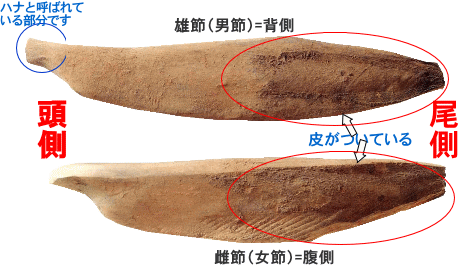
A certain kind of bonito: The differences and
proper use of ‘Katsuobushi.’

The packs of dried bonito sold in the supermarket can be
roughly divided into two kinds. This division depends on
whether or not it has a mold (as shown in the photograph).
Let’s look at how to identify the difference in taste of the
soup stock and what kinds of simple food are a good match
for each one.
Material
Mold with a dried bonito flakes (called"Karebushi") and
mold without dried bonito flakes (Arebushi)
How to Identify Dried Bonito
There are two different kinds of dried bonito available:
the kind that has sold and the kind that does not. Even in
the bonito Kezuribushi packs that are sold in supermarkets,
the differences are not very well known.
To identify the difference types, you first need to check the
label for the ingredients. The label will either read
‘katsuobushi’ (no mold) or ‘okarefushi’ (with mold).
*By the way, ‘Hana bonito,’ and what is written on the
label, is of no mold Katsuobushi.

The Real Difference Between ‘With Mold’ and ‘Without’
Looking at the actual photograph, you can tell right away
that ‘with mold' has a light brown color and is called ‘枯節’
(Karebushi). The dark ones are ‘with mold’ and called ‘荒
節’ (Arebushi).



In the early steps of making dried bonito it is possible to
make Arebushi into a Karebushi by further processing the
Arebushi. Since Arebushi has to be fumigated, it will take
on the characteristic black finish. This withered appearance
comes from repeated molding. The brown mold will
eventually adhere to a clean surface.


Difference in taste Karebushi and Arebushi
It is easy to tell the difference in taste of dried bonito. With mold bonito (arebushi) has a fragrance and elegant mellow taste making a strong soup.
Without mold bonito (karebushi) has a muffled scent of fish and a smoky odor. The taste by itself makes a modest soup.

Ma-konbu is a common kelp to use when drinking Karebushi and Aretakashi. By changing the Karebushi and Arebushi soup at 1% of the weight for each, we can compare each of the stocks they make.



Karebushi with Mold
Even after straining there is no clouding and the soup remains in a clear state (left). It has a plump and mellow scent.
The umami is stronger than Aratakashi. There is no rough aftertaste and the finish feels elegant and clean.
The soup is clear due to the mould being attached from the state
of AraTakashi. This causes the fat content in the section to
decompose.
No mold Arebushi
The soup is a little cloudy after straining (photo right).
There is an acidity and fish fat content with a variety of tastes mixed together. The flavour and muffled smell remains of fish.
The umami by itself is modest. There is a punch to the flavor that has a stronger fish flavor when compared to Karebushi.
The soup has a hazy impression from that thick white turbidity.
For Proper Use of Dried Bonito For the usual home cooking taste, it is okay to use either one of the dried bonitos. ‘Karefushi' with premium molds is good for soups and boiled dishes such as an elegant blend of boiled egg and custard. The flavor of the soup is perfect Thai food! I’ve got bonito without mold as well as bonito with mold in the freezer. You can use them separately, or
sometimes even mix them together.
Notes
In a restaurant, you can still use the belly side of the dried
bonito or use the back side (the same as when you eat sashimi). The stomach side has a larger amount of fat than the back side. Excluding the Chiai (meat of fish that is dark red from blood), there are many parts that have a proper use.
Recently, Kezuribushi packs have been subdivided into with mold, and now there is one without mold.
The packs of subdivided Karebushi have a little higher price, however, there is no fish smell and the taste is very strong. It is an effective to use as a condiment.
 |  |  |
|---|---|---|
 |  |  |
 |  |  |
 |








